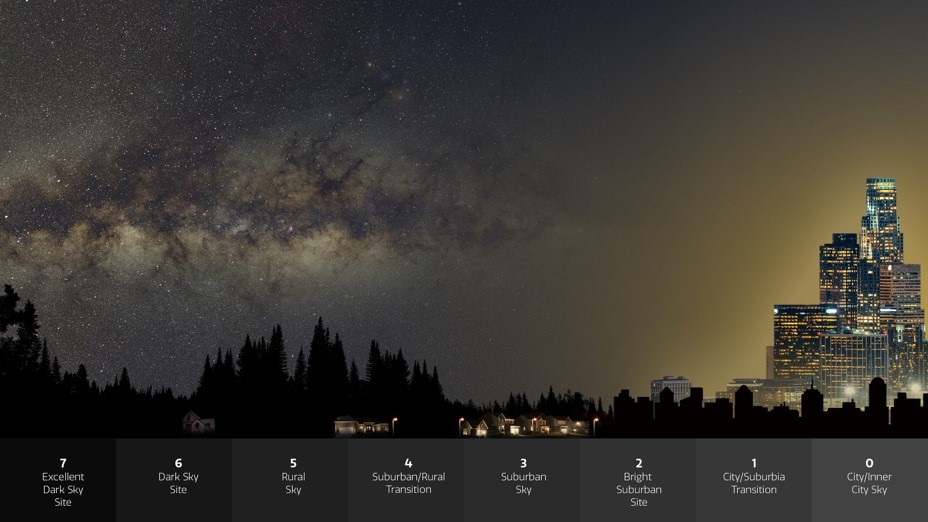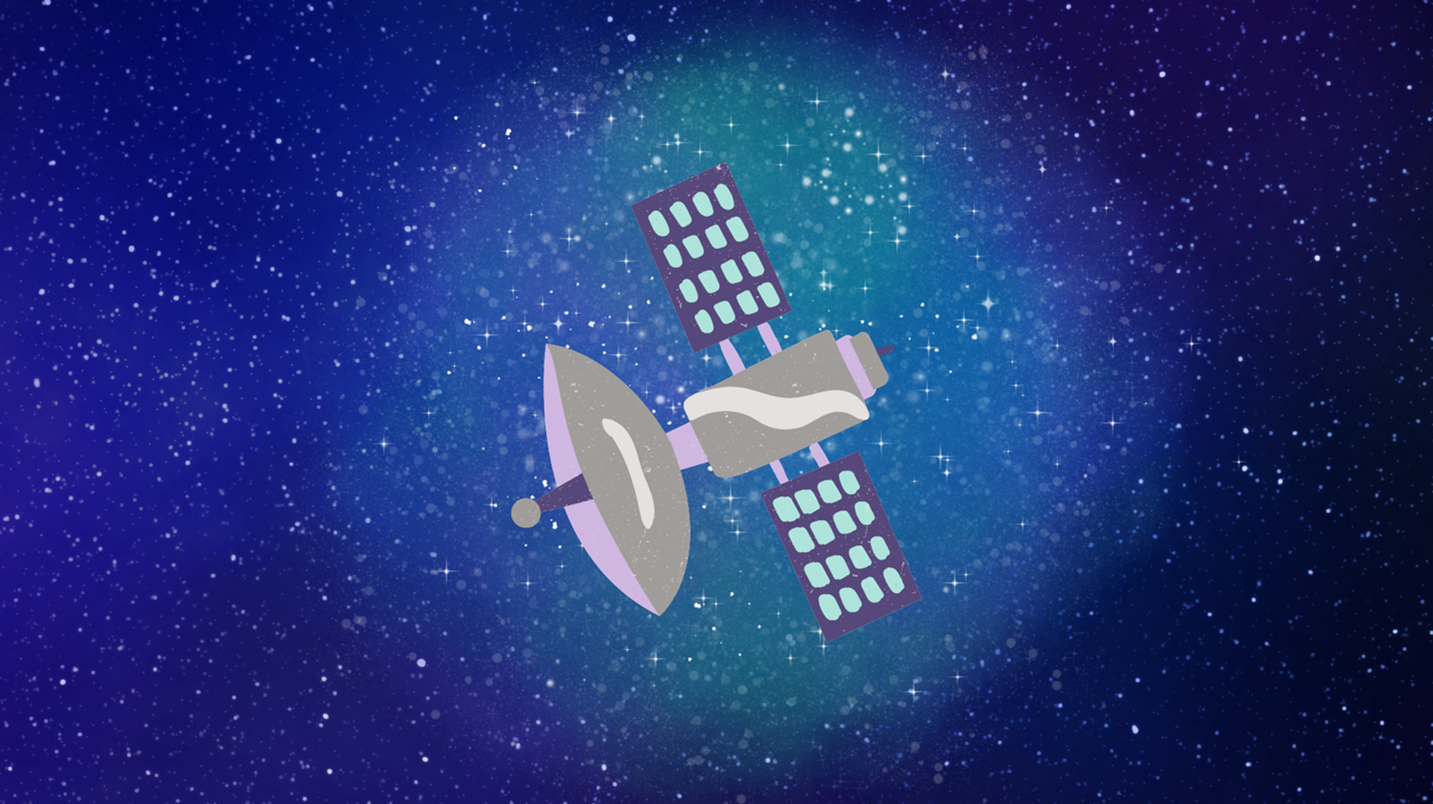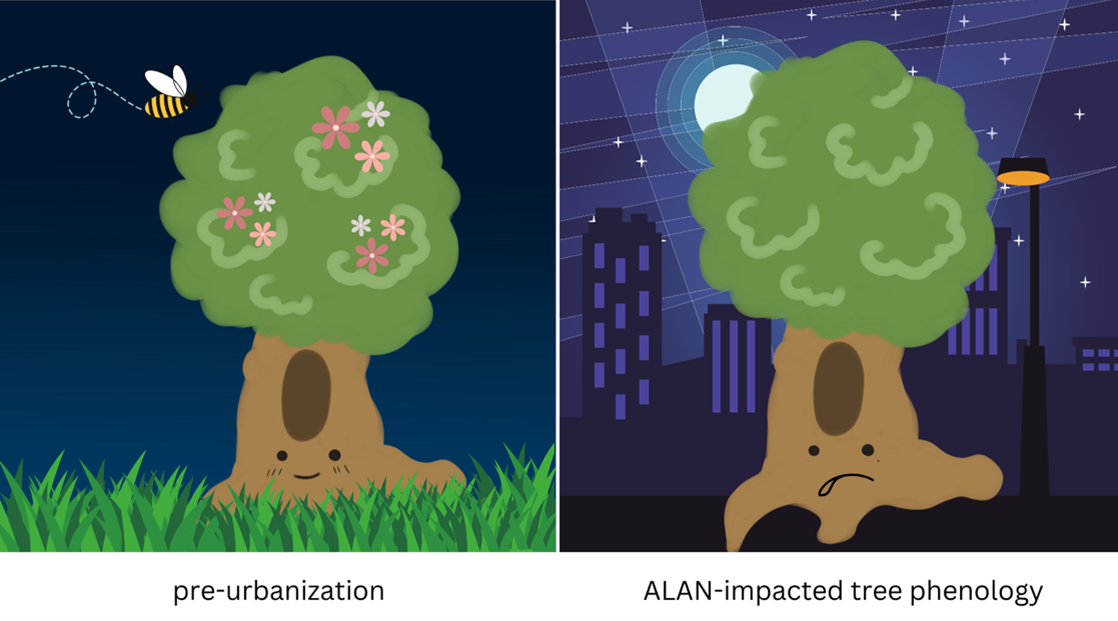VU Graduate Student Uses Satellites to Provide Critical ALAN Data for Public Policy
By: Alexandria Leeper, Evolutionary Studies Graduate Communications Assistant
Imagine you are trying to stargaze. You live in a suburban area where there are little streetlamps, and the darkness of the night envelops most of the sky, making the stars visible. However, you are adjacent to a major city. When you turn your gaze towards that city’s skyline, you notice the stars disappear from sight. Instead, there is a soft haze above the city, a phenomenon known as sky glow.

Brandt Geist, a Ph.D. student in Vanderbilt’s Department of Earth and Environmental Sciences (EES) advised by Assistant Professor Dr. Lin Meng, explained that sky glow is caused by light pollution, in which artificial light at night (ALAN) is scattered by the particles in the air. Light pollution alters the natural day/night cycle in cities, but even areas without direct light pollution are affected by sky glow from cities, according to Meng. Light pollution, stemming from the Industrial Revolution and subsequent urbanization, continues to be a growing problem across the globe, increasing by an average of 2.2% annually, based on a previous study. Stargazing is not the only activity affected, however, as Geist emphasized that many living organisms are sensitive to the amount of light they receive within a 24-hour period.
Geist asserted that ALAN disrupts the natural life progression of urban plants, including growth cycles, the timing of leafing, flowering, and fruiting. Following such, a domino-effect of ecological network disruption and evolutionary changes can occur. Geist explained, “the timing of plant growth cycles originally matches that of other organisms, but when plant phenology changes or changes at a different rate, it leads to a mismatch.” For example, in a disrupted plant-pollinator relationship, insects that rely on the ‘buds’ of trees for food may need to adapt if these resources become unavailable at their usual times. This disruption can force insects to alter the timing of their life cycles, which in turn can impact their predators and have cascading effects on the ecosystem.”

According to Geist, healthy trees are required for human survival, as they are essential components of the global ecological landscape, absorbing the excess carbon contributing to global warming and climate change, moderating temperature, in addition to enhancing air quality. Geist stated, “ALAN disrupts ecosystems by indirectly impacting the carbon cycle, water cycle, and other natural processes. These disruptions affect ecosystem services that trees provide and that humans rely on.”
Geist’s Research on ALAN Policies
Geist received pilot grant funding from ESI to quantify the efficacy of ALAN mitigation policies in reducing light pollution and preserving plant phenology in two pairs of Northeastern U.S. cities, New York City and Washington D.C. (with policies) and Newark and Philadelphia (without policies). Meng explained that the cities were selected on the bases of having four clear seasons to make phenological analyses possible. The project, however, would not be possible without interstellar innovations.

One such interstellar innovation, the SDGSAT-1 satellite, provides Geist with high resolution data that allows him to distinguish the prevalence of specific wavelengths of light at night. A NASA product, the Visible Infrared Imaging Radiometer Suite (VIIRS) Global Land Surface Phenology (GLSP) dataset will allow Geist to determine what phase of their natural season plants are in, such as flowering, for example. Geist explained that the VIIRS GLSP data is generated on satellites orbiting around the earth detecting the reflected light and other surface properties to infer stages of plant development. Geist will compare the ALAN exposure data from SDGSAT-1 to disruptions in urban tree phenology from the VIIRS GLSP dataset.
As a next step for the project, Geist mentioned “working with an even finer resolution dataset to identify specific sources of light causing light pollution.” According to Geist, this will be the first study correlating levels of ALAN and its spectral composition to tree phenology in cities with and without ALAN policies, making analyses of aggregate light data the pertinent first step.
Geist will also be conducting “ground truth observations,” which will involve a Sky Quality Meter (SQM) attached to automobiles that can capture the ground level, lateral spread of ALAN that satellites cannot detect. He will then be able to quantify the total ALAN experienced by the urban trees by integrating the SQM data with the satellite-generated data.
Potential Impact on ALAN Policies
Meng commented on the interdisciplinary nature of the project, intersecting with urban ecology, remote sensing, and policy. According to Meng, “this direct evaluation of the impact of policy on urban physical environments is very significant and will inform policy makers in terms of developing more sustainable strategies.”

Geist also said that this project’s strength lies in its ability to provide a framework for urban lighting policy and urban planning.
According to Geist, “what I have demonstrated so far with the results from my study is that there is a noticeable difference between cities that have made an effort through policy to reduce ALAN and light pollution. Cities with these strategies in place have seen decreases in ALAN in the following year, compared to cities that don’t have any policies.”
Community Engagement
Geist will be presenting his findings at major scientific conferences, for instance, the Ecological Society of America (ESA) Annual Meeting. According to Meng, these conferences provide opportunities for ecologists to share recent findings, build leadership skills, and engage in professional development. Holding an active leadership role in the ESA, Meng reflected on her own experiences, “when I was a student and early in my career, I got a lot of support from the society, including a travel award. I got involved in the leadership of the Human Ecology section and served as the Council Speaker of the ESA, with opportunities to learn how things worked and the visions of the organization. I learned a lot because I got involved in a community and people helped me, so I want to give back by helping other students with their careers and professional development.
During the annual meeting, we organize multiple events including social gatherings for students early in their careers to share their experience and connect. We also offer travel awards from the human ecology section to provide financial support for students attending meetings.”
Geist also plans to engage the communities within the study’s various locations. Public speaking events explaining the implications of his research findings will serve as outreach efforts. As described in Geist’s pilot grant application, “…engaging with DarkSky International organization in each of the study’s cities will allow my research findings to directly inform the advocacy of citizens working together to promote light pollution mitigation strategies and legislation.”
Future Directions
Meng seeks to expand the spatial scope and temporal scope of the data collected in this trailblazing study, as there are more cities that have started implementing different levels of light reduction policy. Geist echoed this resolve to eventually expand this research project globally, through a replicate study in international cities, as plant types and their response to light pollution reduction will vary across different regions. Nevertheless, this present study will establish the foundational methodology, paving the way for future scalability and providing valuable insights for policymakers and urban planners worldwide.
Vanderbilt Community Support
Meng, whose research lab focuses on climate change’s impact on the ecosystem, remarked on Vanderbilt’s strong community and support behind climate change research. This sense of community is what attracted Meng to Vanderbilt. She commented, “there are a lot of people from the engineering school to sociology that study the climate from very different perspectives, so we have several small working groups in which people get together to talk about and display collaboration—truly interdisciplinary efforts.”
Geist’s Personal Motivations
Geist attributes his involvement in environmental science to the mentorship he received in his high school environmental science class. “I had a really great teacher that really supported my interest and assisted me with doing experiments outside of class and so I got really interested in the scientific process and applying it to environmental problems.”
Geist expressed that he aspires to have a career in environmental research within government organizations, such as the Environmental Protection Agency, or within academia.